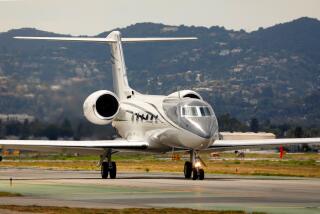Corporate Jets Face an Image Problem
- Share via
Last month, a corporate jet flying from Brazil to New York collided with a Boeing 737 in midair above the Amazon jungle. The 737 airliner crashed, killing all 155 people aboard.
The seven people on board the smaller plane survived.
Two weeks ago, a Gulfstream corporate jet strayed onto an active runway at Los Angeles International Airport, causing a SkyWest regional jet taking off with 39 people to slam on its brakes while traveling 115 mph.
Despite these and other high-profile incidents involving corporate jets, aviation safety experts say their use is just as safe as flying on a commercial plane. “It’s always hard to generalize about aviation safety,” said James K. Coyne, president of the National Air Transportation Assn., an aviation business trade group based in Alexandria, Va. But corporate jets are “safer than scheduled airlines.”
For most travelers, the safety of a corporate jet isn’t as much a factor as price. Corporate jets are still reserved for the well-heeled. Even chartering a jet for one flight costs thousands of dollars an hour.
Even so, the number of corporate jets in the air has steadily increased since the Sept. 11, 2001, terrorist attacks, a direct response from business travelers to the increased hassle of flying commercially.
Since 2002, the size of the U.S. business jet fleet has increased by about 10%, according to Boca Raton, Fla.-based Robert E. Breiling Associates Inc., which has been compiling and analyzing business jet accident data since the 1960s.
The number of business jets now flying is slightly more than 10,000, up from 9,439 in 2002.
Demand for new corporate jets is at its highest level ever, according to the 2005 Honeywell Aerospace Business Aviation Outlook. It projects that 9,900 new corporate jets will be delivered by 2015.
Officials say there is room in the skies for more small planes. “There is plenty of capacity,” said Steve Brown, a former top official at the Federal Aviation Administration. He is now senior vice president of operations for the Washington--based National Business Aviation Assn., a trade group.
A 2005 FAA regulation changed the way planes are separated while in flight and instantly doubled the nation’s air capacity. About 20 airports around the country are building new runways and ramps to add ground capacity, Brown said.
In addition, there is plenty of room in the nation’s many small airports. “There are some congested airports, but only a couple of dozen of the more than 5,000 public-use airports” in the U.S., Brown said.
The fastest-growing segment of the corporate jet market is fractional jets, which allow individuals or companies to buy a share of a jet or a set number of hours using a “jet card.”
“Fractional jets have been flying for 10 years without an accident,” said Coyne of the national transportation association.
An analysis of National Transportation Safety Board and FAA data on aircraft accident rates by Breiling found that flying on corporate jets has steadily become safer in the last 10 years.
Commercial airlines were about three times as likely to have had an accident in 2005 versus corporate jets based on hours flown. But although corporate jets had fewer accidents than commercial airlines, the odds of it being fatal were higher.
Even so, the industry recognizes that it has an image problem.
“If you went out and asked 100 people if they were afraid to fly in a big airplane, probably no more than 3 or 4% would say yes,” Coyne said. “Whereas if you asked about a small plane, 10% or maybe more would say they’d be afraid.”
Many pilots of corporate jets are former military or commercial pilots and are already well-trained, Coyne said. They continue to undergo training to keep up with FAA, employer and insurance requirements. The planes they are flying have the latest technology.
“Corporate airplanes typically have better technology on them than any other planes other than military,” he said.
The only way to counter the fear of flying in small planes is to eliminate accidents, he said. To do that, the industry is taking safety a step further than pilot training and technology and borrowing a page out of the commercial airline industry’s playbook.
“The big step up in order of magnitude ... is to train the whole company in safety,” he said, from the president of the company to the guy who puts air in the planes’ tires.
The airlines instituted the system decades ago, when people still thought it was risky to fly on commercial planes. Today there are still those who fear flying, but the majority of the public knows that flying on an airline is one of the safest forms of transportation.
Coyne hopes for the same attitude adjustment toward corporate jets.
“Clearly it is a much higher number concerned about safety in small planes,” he said. “Whether that fear is unfounded or not is beside the point.”
More to Read
Inside the business of entertainment
The Wide Shot brings you news, analysis and insights on everything from streaming wars to production — and what it all means for the future.
You may occasionally receive promotional content from the Los Angeles Times.










